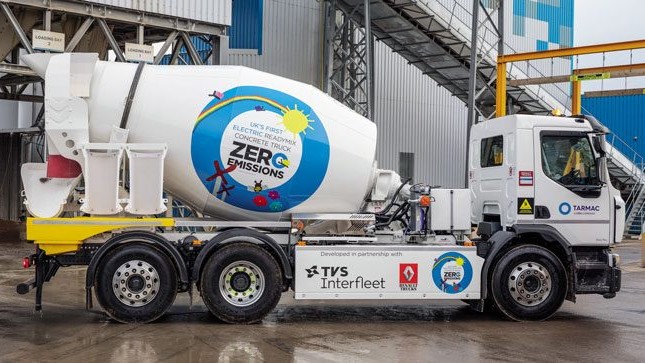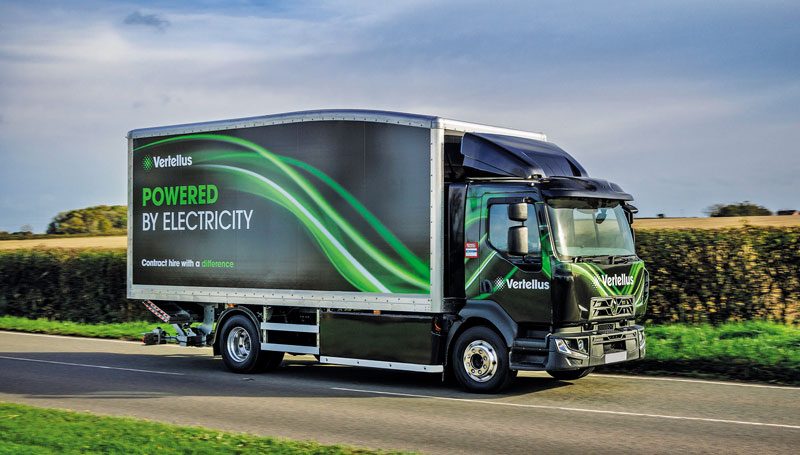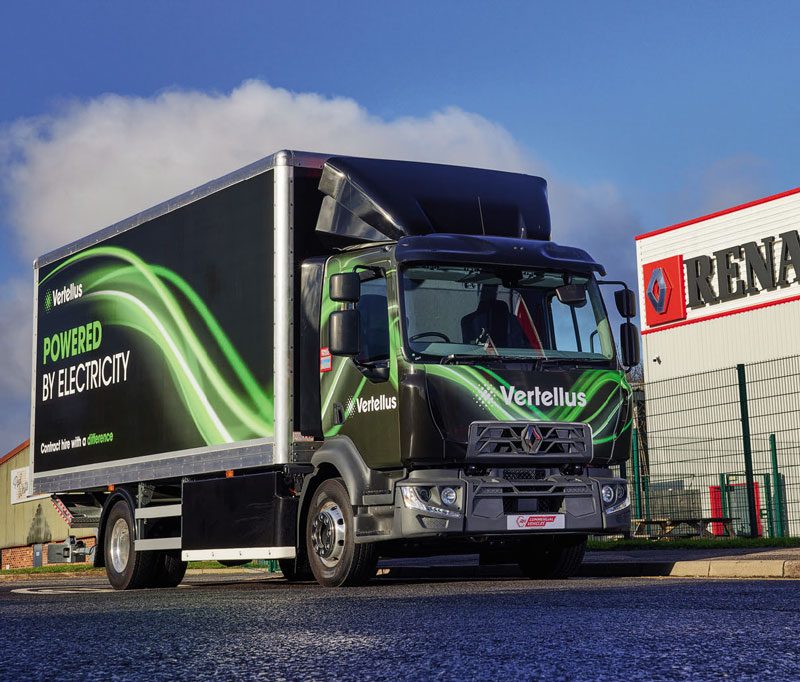
Can an electric concrete mixer offer definite advantages over its diesel-powered counterparts?
Renault Trucks sees itself as a leader in electromobility in the UK. Although it has sold only a handful of zero-tailpipe-emission trucks, it’s certainly doing the groundwork. Last year, it set up the contract hire firm Vertellus (see opposite), offering a unique try-before-you-buy option for hauliers interested in running battery-powered trucks. It also actively targets niche sectors and works closely with bodybuilders and operators to design bespoke electric trucks.
A great example is Europe’s first electric concrete mixer, which has just gone on the road with building materials company Tarmac. The E-Tech D 6×2 27-tonner, which has been more than three years in the making, is a joint project between the operator, Renault Trucks and bodybuilder TVS Interfleet/McPhee.
“The idea originated with Renault Trucks,” explains Tarmac’s senior manager of logistics development, Ben Garner. “We run an innovation challenge through our procurement teams, where we get all sorts of suppliers coming up with brilliant ideas about how to decarbonise parts of our business. And the electric mixer truck was a proposal that Renault Trucks brought to the table in partnership with TVS Interfleet.”
One of the first steps in the project was for TVS and Renault to put sensors on a regular Tarmac mixer, which allowed them to gain real-world data on its usage. The information gathered confirmed the suspicions of both parties that they could indeed produce a vehicle capable of doing everything Tarmac required of it.
Garner says the project was far more complicated than simply replacing a diesel engine with batteries and an electric motor. The finished truck needed to offer tangible improvements over an equivalent diesel vehicle from the start.
He explains that of the 1500 trucks on Tarmac’s UK materials fleet, electrification lends itself best to concrete mixers (of which it runs about 500). Most construction is based in urban areas, and this especially applies to concrete delivery. So, while the energy draw might be high with a mixer, the mileages are comparatively low.
Although based in England’s second-largest city, Birmingham, this truck rarely travels more than a 16km round-trip to make its deliveries. It has a range of about 120km, allowing it to carry out five or six daily deliveries. “So, the truck can effectively do everything we need of it,” says Garner.
When I ask him what lessons he’s learned from running this electric mixer, I’m surprised to discover that the pros easily outweigh the cons. “The really obvious negative is that we’ve found it to be too quiet,” he says. “So, we’re working with Renault to retrofit a white-noise sound for driving forwards as well as for reversing.” There was a slight issue around charging, but this was down to someone supplying the wrong cables and was soon rectified.
I had expected him to describe the purchase price as a negative – after all, electric trucks cost roughly three times the price of their diesel equivalents – but he didn’t.
“We view it on a total cost of ownership basis over seven years,” he explains. “Yes, it is more expensive to buy, but the operating costs are substantially lower.”
He says not only is electricity cheaper than diesel (it is being charged using electricity generated by solar panels at Tarmac’s Birmingham Asphalt Plant), but so are maintenance costs. Over seven years, it is expected to work out 10% more costly than a diesel equivalent.
“We were certainly very surprised, as was Renault, when the cost model came out that close,” he admits.

In the early stages of development, it was anticipated that the electric mixer would suffer in terms of payload. However, these fears never materialised thanks to numerous weight-saving developments made by TVS Interfleet.
“It put a lot of effort into reducing the truck’s kerb weight, which allowed the fitting of a 5.8m3 drum. “The average for a vehicle like that is between 5.6m3 and 5.7m3 , so 5.8m3 has been a really pleasant surprise.”
Continuing with the pros (including the obvious lack of tailpipe emissions, and the positive PR that comes with running an electric truck) is improved safety. Because of their high/dynamic centre of gravity, concrete mixers are prone to rollovers. As the drum rotates, so the concrete travels up the side of it. The faster it turns, the more momentum the concrete has, and the higher it moves. If a driver enters a bend too quickly, just as the concrete is in its highest position, there’s a danger that it might topple over.
While developing this truck, TVS Interfleet introduced some innovations to help. Electric trucks already have a lower centre of gravity due to the location of the batteries on the chassis rail. However, TVS has improved it further by reducing the height of the water tank. Additionally, it has lowered the speed of the drum rotation, which again aids stability (see below).
What’s more, according to TVS Interfleet technical director Kevin Walker, in the future, it will look at introducing intelligent drum speeds, which will automatically slow the rotation speed as the truck enters a bend.
Another safety improvement relates to an improved drum restraint.
“In a rollover situation, this invention helps to keep the drum in position,” explains Walker. He says it typically takes 0.5G of force to dislodge the drum. However, thanks to this truck’s new design, the figure has been increased to 1.5G.
“So, it’s effectively three times as safe.”
Another unexpected advantage has been that the truck can make deliveries inside buildings. “Normally on a construction site like that, you would need huge extractor fans to take the fumes out, but you don’t need them with this,” Garner says.
Walker stresses that the project has been a success due to collaboration between all three parties and believes this will also be the case going forwards, saying, “the bodybuilder can’t do it on their own, the OEMs can’t do it on their own, and the customer can’t do it on their own.”

TRY BEFORE YOU BUY
Contract hire firm Vertellus, co-owned by Renault Trucks UK and its dealers, operates a fleet of 30 E-Tech D rigids, and a mix of boxes, curtainsiders and fridge vans, which are loaned for three-month periods. While this route is vastly more cost-effective than buying a truck outright, only to find that it doesn’t suit an operator’s business, there’s still a significant cost.
Vertellus charges £1.50 ($3) per kWh, with customers contracting a minimum of 3000kWh per month, equivalent to 40,000km per annum. This works out at £4500 ($9100) per month and includes all expected standard full contract hire services and the use of a Zenobē-supplied vehicle charger.
“I’m not saying it’s cheap, but in the context of an opportunity to try a vehicle in your home setting, in your own operation, and do your own research and development, which is something that is currently impossible, it’s actually good value,” reckons Vertellus MD Nigel Baxter. “Personally, I don’t like to buy cheap things. I buy good value. And I think this is a good-value opportunity.”

THE BODYBUILDER
TVS Interfleet technical director Kevin Walker reckons this project enabled the company to “forget everything we knew about mixers and start again”. As a result, the finished truck features several patented innovations, all of which can be used in future electric mixers, and some can also be transferred to diesel-powered trucks.
A good example is how the mixer drum is powered. “The first question was would we use Renault’s ePTO, or go direction connection,” says Walker. “The preference was to go direct connection, but due to Renault’s timeline, we won’t have that until later this year. So, then it was a case of moving their mechanical PTO to a position where we could run a hydraulic system to drive the drum.
“But where it gets really clever is that we started to realise that by using electrification and a disconnect between the standard drive model of an ICE, which is associated with engine speed, we can control the mixer away from that setup. So, there is an absolute disconnect between the two. This meant that we could slow down drum speed revolutions, which would make it safer.” TVS initially assumed this would have energy-saving benefits but soon realised that other advantages included safety and a quieter operation.

Walker says TVS developed an entirely new human interface. Whereas, traditionally, the controls are cable- operated, with this mixer, there’s an interface on the screen, which allows drivers to add water, change the rotation speed, charge (load) and discharge (unload) the concrete.
TVS also took the opportunity to make the drum lighter by changing the material it is constructed from. And by reducing the revolutions, it is likely to wear better, too, increasing its longevity by about two years.
“There are a lot of other things that are scheduled to happen for this mixer further down the line,” he says. “We have about seven patents on this vehicle regarding what we’ve already done and what is still to come. We really started to think outside of the box on this and went from effectively being fabricator welders and bodybuilders into software developers. It is an exciting project for us.”
Read more
From our travels
0 Comments1 Minute
Maximum nostalgia
0 Comments5 Minutes
Meeting Volvo’s VNL
0 Comments13 Minutes
A yank with a Dutch touch
0 Comments8 Minutes








